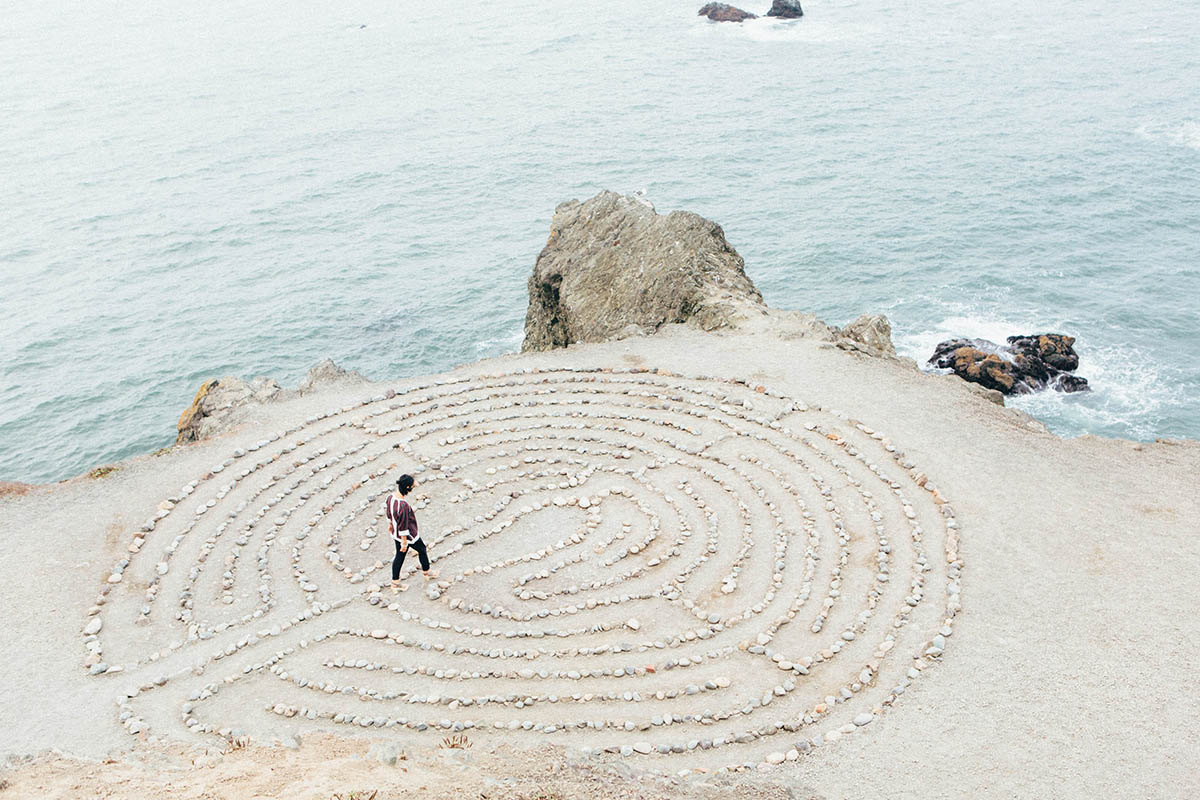It is one of our most celebrated milestones in life: Walking. Without realising it, we start taking it for granted and walk from place A to destination Z on autopilot. Once we hit adulthood, walking places oftentimes becomes rushing about, trying to keep up with our busy schedules.
We easily forget the simple pleasure of our feet touching the ground, moving us forward while taking in the present moment, everything that’s happening around us.
Walking meditation is a form of mindfulness, a shift of consciousness, that can be pracised anywhere and with your eyes wide open.
Through focusing on the rhythm of of your walk you bring awareness to your movements and re-connect with your body as well as the world around you.
In this blog post, you’ll learn how walking meditation is different to just taking a stroll in nature, what benefits it holds and introduces you to various approaches on how to practice walking meditation.
Benefits of Walking Meditation
Most of us live a very sedentary life. We sit at work, we sit while driving a car or going places on public transport, we sit at home while having meals, reading a book or watching TV. We are all more or less aware of how detrimental this lifestyle and our fixation on various screens is to our physical and mental health. That’s one of the reasons why mindfulness exercises like meditation, yoga, qigong or tai chi have become extremely popular in recent years.
Walking meditation combines the proven benefits of a meditative state with those of one of the most natural and easily accessible movements – walking. There’s no need for classes or instructors, set times or places. It can be done indoors or outside and doesn’t require any equipment or special preparation.
Some people struggle with sitting meditation for various reasons. Walking meditation can be an entry point for beginners who want to build a meditation practice or a mindfulness exercise in its own right that promotes physical and mental wellbeing.
These are some benefits you can expect from practicing walking meditation regularly:
-
Can help break cycles of rumination, calms the mind and promotes mental clarity
-
Improves ability to focus as well as awareness of and connection with one’s own body as well as one’s surroundings
-
Releases tension, improves fitness and overall physical health
-
Helps with digestion and improves sleep
-
Helps overcome lethargy
-
Promotes gratitude and genuine joy

How to practice walking meditation
You can practice walking meditation any time you are walking. This can be in the comfort of your own home, your backyard, while you are out and about in your town or city or you could pick a peaceful place in nature like a nearby forest, a beach or a quiet country lane.
If you are just starting out, it might be best to choose a secluded place. Ideally, there will be little distraction which will make it easier to turn and keep your focus inwards. You want to feel safe to explore this new practice without worrying about people observing or trying to interact with you.
You are not trying to change the way you walk. On the contrary: You want to keep your movements as natural as possible. You do slow them down considerably, though, which will help you to enter a state of focus and awareness.
Things to know and do before you start your walking meditation practice
As it is not about reaching a destination, all you need is enough space to make 10 to 30 paces before you turn around. You should set aside 10 to 20 minutes to give this mindfulness exercise your undivided attention. Start small but aim for a regular practice to get the most benefits of walking meditation.
Before you start, you want to make sure you have fully arrived in the space you have chosen for your walking meditation and anchor yourself in the present moment. Take slow, deep breaths. Feel the solid ground under your feet and become aware of the sensations in your body.
How are you feeling and where are you feeling it? What thoughts are predominant right now? There is no ‘right’ or ‘wrong’, no ‘should’ or ‘shouldn’t be’. Simply notice and acknowledge what is before bringing your attention back to your breath and the ground under your feet.
Once you are present in the place you have chosen for your walking meditation and within yourself, it’s time to take the first step. There are various ways to practice walking meditation. Use the different approaches we describe here as a guideline and explore whatever suits your needs best.
Walking meditation – first steps
When you are ready, begin to walk in a relaxed, natural manner but keep your steps slow and deliberate. You can leave your hands hanging at your side or clasp them in front of you or behind your back – whatever feels most comfortable to you.
While you put one foot in front of the other, you want to focus your attention on the movement of your body. Become aware of your right foot as you raise it off the ground, feel the muscles that are involved in raising your leg, how you shift your balance, push yourself forward, slowly drop your leg, where your foot touches the ground and how it presses into the Earth to support your body while you start raising your other foot off the ground. Allow yourself to become anchored in the rhythm of your steps.

Walking meditation – first steps
Whenever you notice your attention straying elsewhere, gently and without judgement re-direct your mind and bring your focus back to your body, your legs, your feet and everything that is involved in the movement of walking. After 10 to 30 paces, turn around and walk back.
You can eventually expand your awareness to your surroundings: notice the surface upon which you are walking, any noises or smells. There is no need to categorise or analyse any of these. Simply become aware.
If you find it helpful, you can integrate affirmations like those suggested by Buddhist monk and peace activist Thich Nhat Hanh into your walking meditation practice: “Breathing in, I know Mother Earth is in me. Breathing out, I know Mother Earth is in me.” or “Breathing in, I calm my body. Breathing out, I bring peace into my body.”
Most importantly, don’t force anything that doesn’t feel natural. Be patient with and accepting of your wandering mind and how easily it will get distracted. Allow yourself time to become comfortable with becoming so intemately aware of your body and movements. And be kind towards yourself with whatever comes up during this mindfulness exercise.
New Life Portugal
If you would like to discover and explore different meditation techniques or deepen your practice in the stunning setting of the Serra Da Estrela, have a look at the programs we offer at New Life Portugal.
Our programs can all be tailored to your individual needs. Each of them involves mindfulness practices like yoga, meditation, qigong, etc.
It is our mission to support anyone who wants to cultivate sustainable wellbeing in their life.
If you have any questions or would like to receive more information about our wellness centre or program, please don’t hesitate to contact us.